Abstract
Recent findings suggest that supplemental calcium could lower the abnormally high proliferation rate found in the colonic mucosa of subjects at high risk for colon cancer. In this double blind controlled study, this effect in volunteers previously operated upon for a colorectal adenocarcinoma was tested. Thirty subjects were randomised to receive either elemental calcium 1200 mg/day or a placebo. Mucosal proliferation was measured with tritiated thymidine labelling before and after the 30 day intervention period. Diets, faecal pH and the concentration of calcium and bile acids in the aqueous phase of feaces were also measured. Labelling index did not differ significantly in the two groups before intervention (placebo 4.0(2.4) v calcium 4.9(2.9), but the difference approached significance afterwards (4.4(2.4) v 6.5(3.4), p = 0.06). Individual changes occurring with intervention were tabulated and comparison of the means for the groups was not significant (delta = 0.3 vs delta = 1.8, p = 0.11). Calcium concentration, faecal pH and deoxycholic acid concentration increased in the calcium group (p = 0.02, 0.005 and 0.004 respectively). Calcium does not show any effect in decreasing colonic mucosal proliferation in this high risk group for colon cancer; it may increase faecal pH and the production of deoxycholic acid in the colon.
Full text
PDF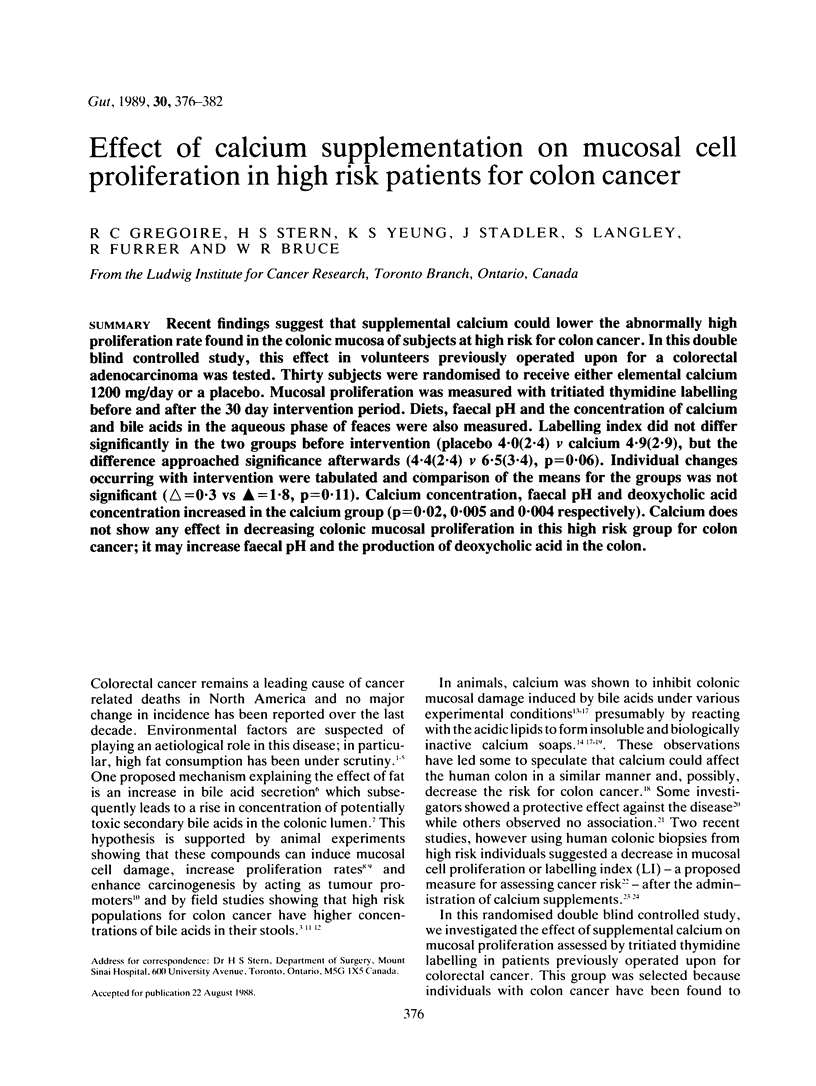
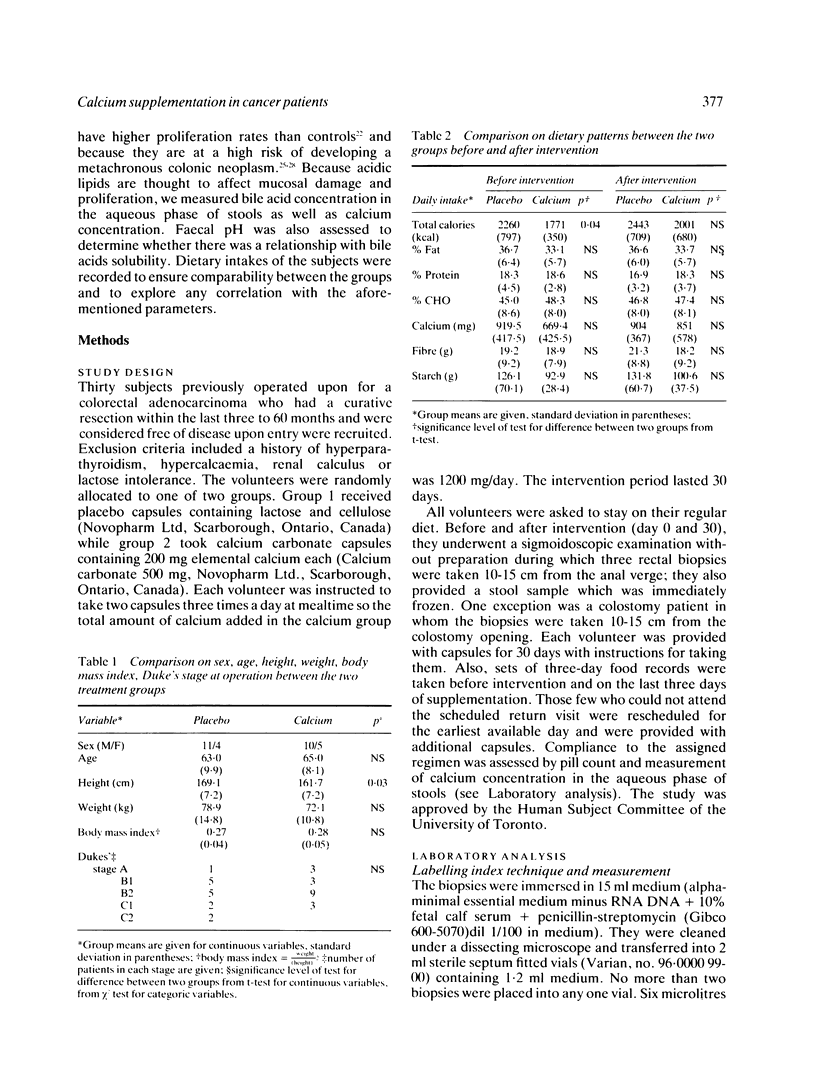
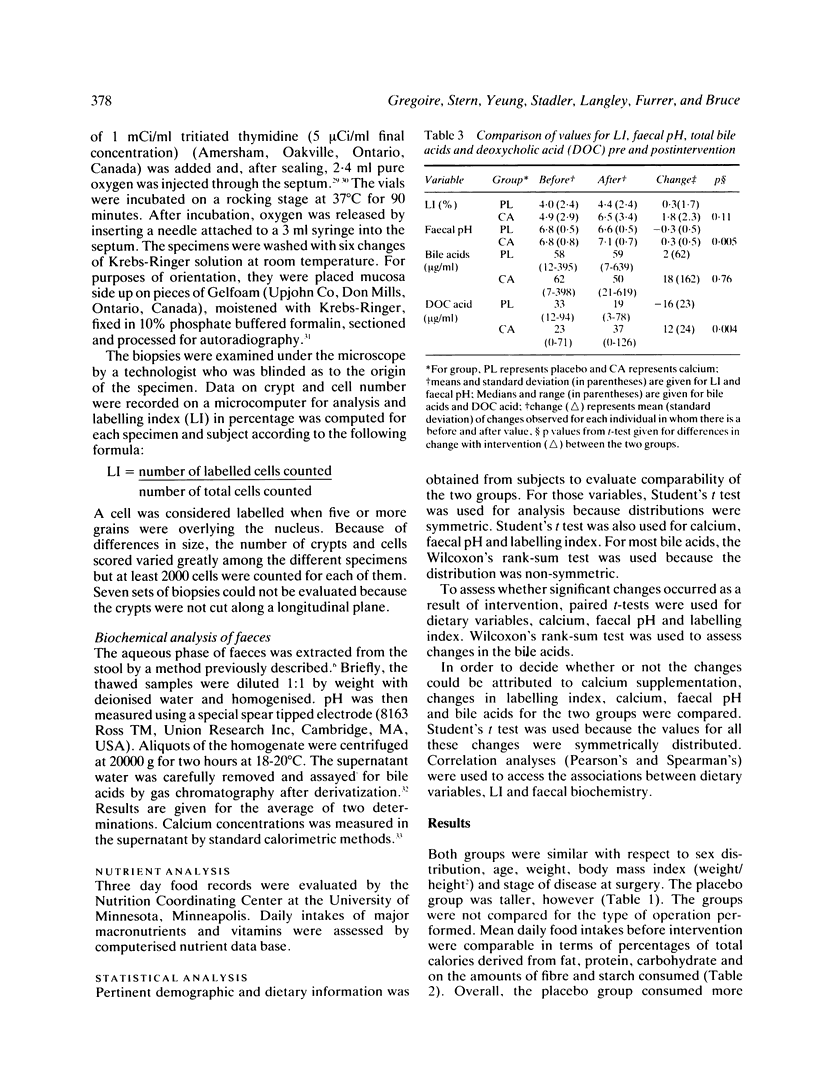

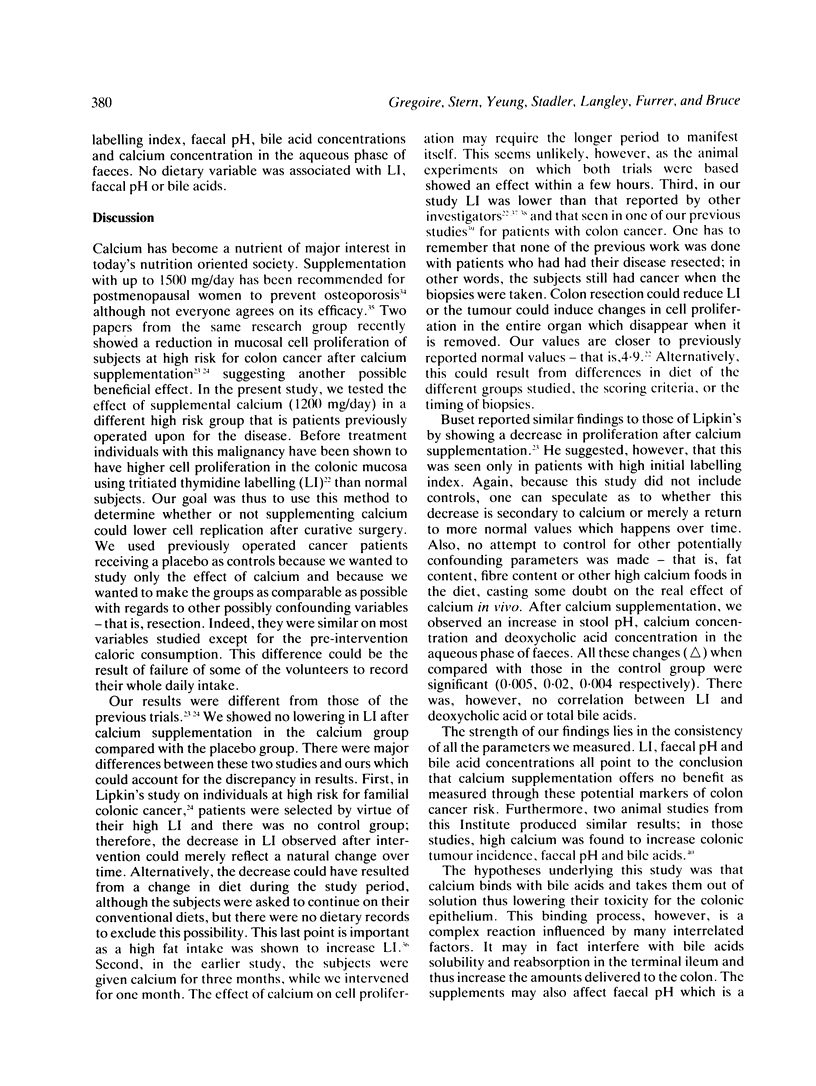
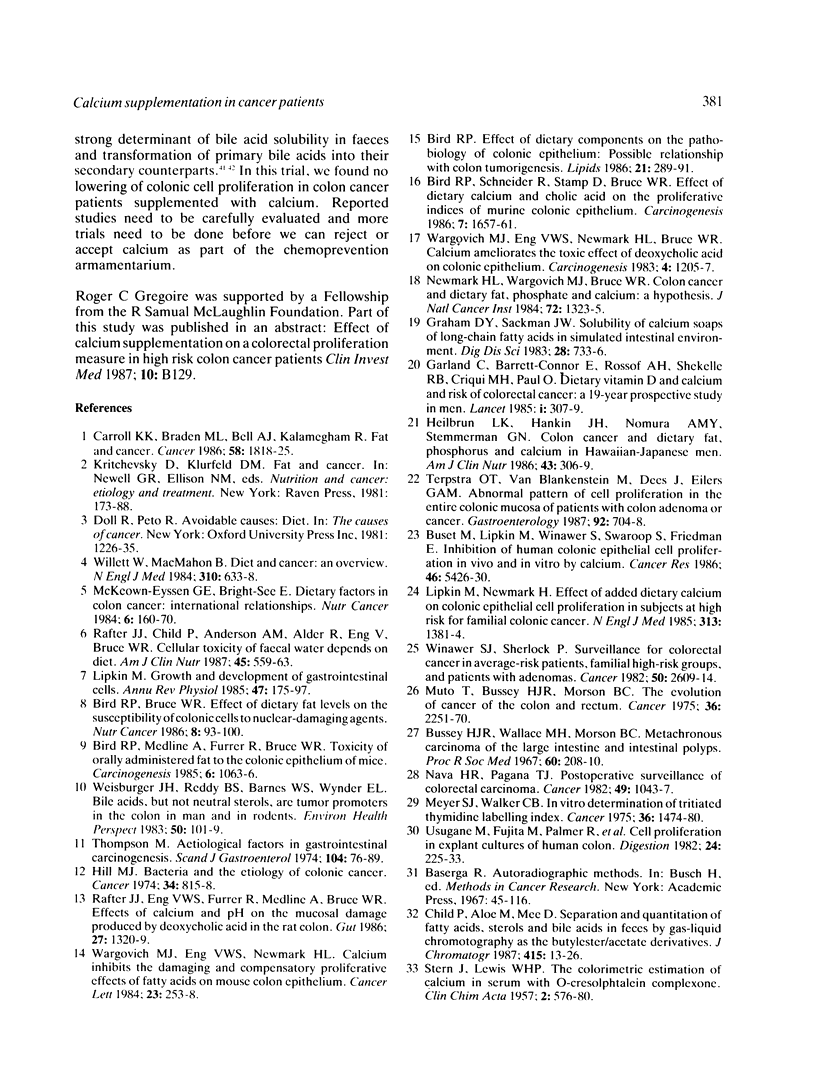

Selected References
These references are in PubMed. This may not be the complete list of references from this article.
- Bird R. P., Bruce W. R. Effect of dietary fat levels on the susceptibility of colonic cells to nuclear-damaging agents. Nutr Cancer. 1986;8(2):93–100. doi: 10.1080/01635588609513881. [DOI] [PubMed] [Google Scholar]
- Bird R. P. Effect of dietary components on the pathobiology of colonic epithelium: possible relationship with colon tumorigenesis. Lipids. 1986 Apr;21(4):289–291. doi: 10.1007/BF02536415. [DOI] [PubMed] [Google Scholar]
- Bird R. P., Medline A., Furrer R., Bruce W. R. Toxicity of orally administered fat to the colonic epithelium of mice. Carcinogenesis. 1985 Jul;6(7):1063–1066. doi: 10.1093/carcin/6.7.1063. [DOI] [PubMed] [Google Scholar]
- Bird R. P., Schneider R., Stamp D., Bruce W. R. Effect of dietary calcium and cholic acid on the proliferative indices of murine colonic epithelium. Carcinogenesis. 1986 Oct;7(10):1657–1661. doi: 10.1093/carcin/7.10.1657. [DOI] [PubMed] [Google Scholar]
- Buset M., Lipkin M., Winawer S., Swaroop S., Friedman E. Inhibition of human colonic epithelial cell proliferation in vivo and in vitro by calcium. Cancer Res. 1986 Oct;46(10):5426–5430. [PubMed] [Google Scholar]
- Bussey H. J., Wallace M. H., Morson B. C. Metachronous carcinoma of the large intestine and intestinal polyps. Proc R Soc Med. 1967 Mar;60(3):208–210. [PMC free article] [PubMed] [Google Scholar]
- Carroll K. K., Braden L. M., Bell J. A., Kalamegham R. Fat and cancer. Cancer. 1986 Oct 15;58(8 Suppl):1818–1825. doi: 10.1002/1097-0142(19861015)58:8+<1818::aid-cncr2820581406>3.0.co;2-4. [DOI] [PubMed] [Google Scholar]
- Child P., Aloe M., Mee D. Separation and quantitation of fatty acids, sterols and bile acids in feces by gas chromatography as the butyl ester-acetate derivatives. J Chromatogr. 1987 Mar 20;415(1):13–26. doi: 10.1016/s0378-4347(00)83187-4. [DOI] [PubMed] [Google Scholar]
- Deschner E. E., Maskens A. P. Significance of the labeling index and labeling distribution as kinetic parameters in colorectal mucosa of cancer patients and DMH treated animals. Cancer. 1982 Sep 15;50(6):1136–1141. doi: 10.1002/1097-0142(19820915)50:6<1136::aid-cncr2820500617>3.0.co;2-a. [DOI] [PubMed] [Google Scholar]
- Garland C., Shekelle R. B., Barrett-Connor E., Criqui M. H., Rossof A. H., Paul O. Dietary vitamin D and calcium and risk of colorectal cancer: a 19-year prospective study in men. Lancet. 1985 Feb 9;1(8424):307–309. doi: 10.1016/s0140-6736(85)91082-7. [DOI] [PubMed] [Google Scholar]
- Graham D. Y., Sackman J. W. Solubility of calcium soaps of long-chain fatty acids in simulated intestinal environment. Dig Dis Sci. 1983 Aug;28(8):733–736. doi: 10.1007/BF01312564. [DOI] [PubMed] [Google Scholar]
- Heaney R. P., Recker R. R., Saville P. D. Menopausal changes in calcium balance performance. J Lab Clin Med. 1978 Dec;92(6):953–963. [PubMed] [Google Scholar]
- Heilbrun L. K., Hankin J. H., Nomura A. M., Stemmermann G. N. Colon cancer and dietary fat, phosphorus, and calcium in Hawaiian-Japanese men. Am J Clin Nutr. 1986 Feb;43(2):306–309. doi: 10.1093/ajcn/43.2.306. [DOI] [PubMed] [Google Scholar]
- Hill M. J. Bacteria and the etiology of colonic cancer. Cancer. 1974 Sep;34(3):suppl–suppl:818. doi: 10.1002/1097-0142(197409)34:3+<815::aid-cncr2820340705>3.0.co;2-6. [DOI] [PubMed] [Google Scholar]
- Lipkin M. Growth and development of gastrointestinal cells. Annu Rev Physiol. 1985;47:175–197. doi: 10.1146/annurev.ph.47.030185.001135. [DOI] [PubMed] [Google Scholar]
- Lipkin M., Newmark H. Effect of added dietary calcium on colonic epithelial-cell proliferation in subjects at high risk for familial colonic cancer. N Engl J Med. 1985 Nov 28;313(22):1381–1384. doi: 10.1056/NEJM198511283132203. [DOI] [PubMed] [Google Scholar]
- Maskens A. P., Deschner E. E. Tritiated thymidine incorporation into epithelial cells of normal-appearing colorectal mucosa of cancer patients. J Natl Cancer Inst. 1977 May;58(5):1221–1224. doi: 10.1093/jnci/58.5.1221. [DOI] [PubMed] [Google Scholar]
- McJunkin B., Fromm H., Sarva R. P., Amin P. Factors in the mechanism of diarrhea in bile acid malabsorption: fecal pH--a key determinant. Gastroenterology. 1981 Jun;80(6):1454–1464. [PubMed] [Google Scholar]
- McKeown-Eyssen G. E., Bright-See E. Dietary factors in colon cancer: international relationships. Nutr Cancer. 1984;6(3):160–170. [PubMed] [Google Scholar]
- Muto T., Bussey H. J., Morson B. C. The evolution of cancer of the colon and rectum. Cancer. 1975 Dec;36(6):2251–2270. doi: 10.1002/cncr.2820360944. [DOI] [PubMed] [Google Scholar]
- Nava H. R., Pagana T. J. Postoperative surveillance of colorectal carcinoma. Cancer. 1982 Mar 1;49(5):1043–1047. doi: 10.1002/1097-0142(19820301)49:5<1043::aid-cncr2820490533>3.0.co;2-y. [DOI] [PubMed] [Google Scholar]
- Newmark H. L., Wargovich M. J., Bruce W. R. Colon cancer and dietary fat, phosphate, and calcium: a hypothesis. J Natl Cancer Inst. 1984 Jun;72(6):1323–1325. [PubMed] [Google Scholar]
- Rafter J. J., Child P., Anderson A. M., Alder R., Eng V., Bruce W. R. Cellular toxicity of fecal water depends on diet. Am J Clin Nutr. 1987 Mar;45(3):559–563. doi: 10.1093/ajcn/45.3.559. [DOI] [PubMed] [Google Scholar]
- Rafter J. J., Eng V. W., Furrer R., Medline A., Bruce W. R. Effects of calcium and pH on the mucosal damage produced by deoxycholic acid in the rat colon. Gut. 1986 Nov;27(11):1320–1329. doi: 10.1136/gut.27.11.1320. [DOI] [PMC free article] [PubMed] [Google Scholar]
- Riis B., Thomsen K., Christiansen C. Does calcium supplementation prevent postmenopausal bone loss? A double-blind, controlled clinical study. N Engl J Med. 1987 Jan 22;316(4):173–177. doi: 10.1056/NEJM198701223160401. [DOI] [PubMed] [Google Scholar]
- STERN J., LEWIS W. H. The colorimetric estimation of calcium in serum with ocresolphthalein complexone. Clin Chim Acta. 1957 Dec;2(6):576–580. doi: 10.1016/0009-8981(57)90063-3. [DOI] [PubMed] [Google Scholar]
- Stadler J., Stern H. S., Yeung K. S., McGuire V., Furrer R., Marcon N., Bruce W. R. Effect of high fat consumption on cell proliferation activity of colorectal mucosa and on soluble faecal bile acids. Gut. 1988 Oct;29(10):1326–1331. doi: 10.1136/gut.29.10.1326. [DOI] [PMC free article] [PubMed] [Google Scholar]
- Stadler J., Yeung K. S., Furrer R., Marcon N., Himal H. S., Bruce W. R. Proliferative activity of rectal mucosa and soluble fecal bile acids in patients with normal colons and in patients with colonic polyps or cancer. Cancer Lett. 1988 Jan;38(3):315–320. doi: 10.1016/0304-3835(88)90023-7. [DOI] [PubMed] [Google Scholar]
- Terpstra O. T., van Blankenstein M., Dees J., Eilers G. A. Abnormal pattern of cell proliferation in the entire colonic mucosa of patients with colon adenoma or cancer. Gastroenterology. 1987 Mar;92(3):704–708. doi: 10.1016/0016-5085(87)90021-7. [DOI] [PubMed] [Google Scholar]
- Thompson M. Aetiological factors in gastrointestinal carcinogenesis. Scand J Gastroenterol Suppl. 1984;104:77–89. [PubMed] [Google Scholar]
- Usugane M., Fujita M., Lipkin M., Palmer R., Friedman E., Augenlicht L. Cell proliferation in explant cultures of human colon. Digestion. 1982;24(4):225–233. doi: 10.1159/000198801. [DOI] [PubMed] [Google Scholar]
- Wargovich M. J., Eng V. W., Newmark H. L., Bruce W. R. Calcium ameliorates the toxic effect of deoxycholic acid on colonic epithelium. Carcinogenesis. 1983 Sep;4(9):1205–1207. doi: 10.1093/carcin/4.9.1205. [DOI] [PubMed] [Google Scholar]
- Wargovich M. J., Eng V. W., Newmark H. L. Calcium inhibits the damaging and compensatory proliferative effects of fatty acids on mouse colon epithelium. Cancer Lett. 1984 Jul;23(3):253–258. doi: 10.1016/0304-3835(84)90091-0. [DOI] [PubMed] [Google Scholar]
- Weisburger J. H., Reddy B. S., Barnes W. S., Wynder E. L. Bile acids, but not neutral sterols, are tumor promoters in the colon in man and in rodents. Environ Health Perspect. 1983 Apr;50:101–107. doi: 10.1289/ehp.8350101. [DOI] [PMC free article] [PubMed] [Google Scholar]
- Willett W. C., MacMahon B. Diet and cancer--an overview. N Engl J Med. 1984 Mar 8;310(10):633–638. doi: 10.1056/NEJM198403083101006. [DOI] [PubMed] [Google Scholar]
- Winawer S. J., Sherlock P. Surveillance for colorectal cancer in average-risk patients, familial high-risk groups, and patients with adenomas. Cancer. 1982 Dec 1;50(11 Suppl):2609–2614. [PubMed] [Google Scholar]


